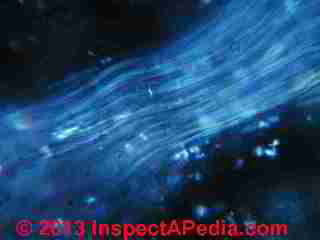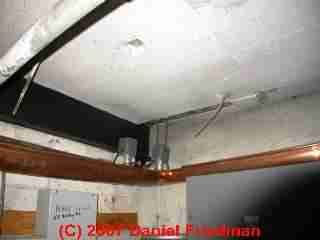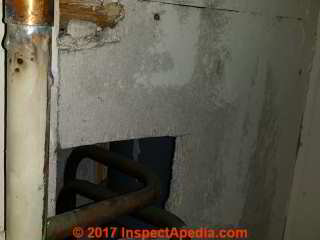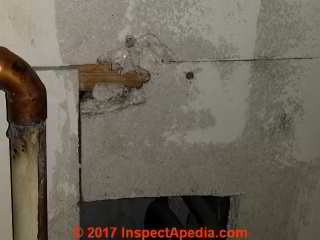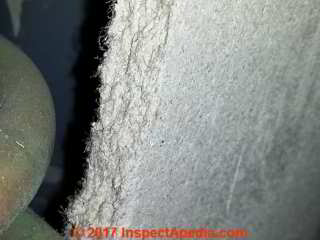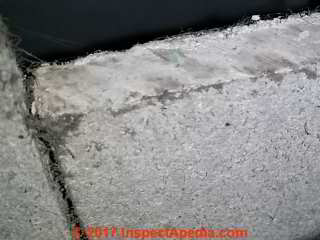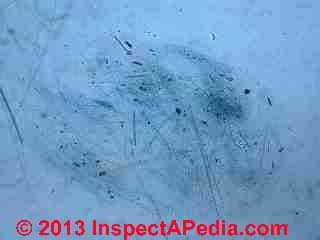 Types of Asbestos
Types of Asbestos
P roperties of Amphibole, Chrysotile, Crocidolite, Amosite, Anthophyllite & Tremolite Asbestos
- POST a QUESTION or COMMENT about asbestos definition, chemical, mechanical, composition, iron content, thermal & other properties
This article describes the principal types of asbestos and explains the differences among Amphibole, Chrysotile, Crocidolite, Amosite, Anthophyllite & Tremolite Asbestos.
This article series describes the physical properties of asbestos including its mechanical, chemical, electrical and related properties both in pure asbestos form and when asbestos is mixed with other materials like cement or rubber. As the author points out, while this is a lenghty article, there is far more detailed information about asbestos properties, chemistry, etc. Page top photo: crocidolite asbestos in the laboratory - ©D Friedman.
InspectAPedia tolerates no conflicts of interest. We have no relationship with advertisers, products, or services discussed at this website.
- Daniel Friedman, Publisher/Editor/Author - See WHO ARE WE?
Types of Asbestos: properties of Amphibole, Chrysotile, Crocidolite, Amosite, Anthophyllite & Tremolite Asbestos
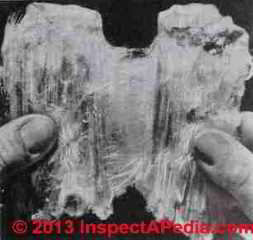 Properties of Amphibole Group Asbestos
Properties of Amphibole Group Asbestos
A review will also be made of the amphibole group of minerals which is generally identified by the formula 2CaO.5MgO.8SiO2H20. The actual composition of the amphibole fibers varies greatly, particularly in comparison to chrysotile.
[Click to enlarge any image]
The variation in composition results in a physical property change of the fibers. This variation requires more rigid controls for obtaining and identifying shipments of amphibole fibers.
Properties of Chrysotile Asbestsos
Chrysotile asbestos in rock form is usually found in soft shades of green; these shades range from a very pale green to a dark green. The Arizona asbestos is often pale yellow.
However, despite its original color, it in- variably becomes white or grayish white when it is opened or fiberized. Its commercial usefulness depends not so much on its chemical composition but on its physical properties.
For textile products, chrysotile asbestos is the most important type of asbestos used because it has the best combination of strength and flexibility. Its resistance to alkalies is very good. However, its resistance to acids is lower than that of other varieties. its specific heat is 0.266 Btu per lb per °F.
From the point of view of structure, chrysotile asbestos is considered a silicate with a sheet structure; this factor makes it the magnesium analog of the kaolin group. In most of its occurrences, chryso'tile which has serpentine or olivine - as its source rock, shows either none or very little ' lime. Its chemical composition is Mg6(0H)6(S4011)H20 or 3MgO-2SiO2-2H20. Chemical composition of fibers can vary from mine to mine, but this variation is not great when compared to the other asbestos fibers.
Although the fibrous structure of many chrysotile fibers is similar, there is often a difference in the operation of separating the individual fibers. Techniques and experience are required both at the mining site and in the manufacturing process in order to obtain good quality and fibrous structures.
Crocidolite Asbestos Properties
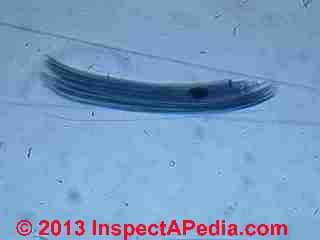 Crocidolite, because of its distinctive color,
is commonly known as blue asbestos. It is easily recognized
by its blue color which appears both in its natural state and
after fiberization.
Crocidolite, because of its distinctive color,
is commonly known as blue asbestos. It is easily recognized
by its blue color which appears both in its natural state and
after fiberization.
When found in nature, the color varies from lavender blue to dark blue. Sometimes red and yellow streaks exist. When the fiber is opened, the dolor of the fiberized structure is lighter in shade than in its original form. The blue color is the result of the high soda content or the iron compounds associated with the rock formation.
Its general chemical formula is 3Na 2 O6FeO2Fe 2 O 3 16- Si0 2 11 2 0. Variation in the composition occurs where sodium may be replaced by potash, ferric or ferrous iron by magnesium or manganese and ferrous iron by aluminum.
The blue asbestos occurs only in very few localities and is mined only in large quantities in South Africa. Its predominate properties include high tensile strength, acid resistance, harshness and resistance to effects of outdoor exposure.
Amosite Asbestos Properties
Crocidolite as well as amosite occurs in metamorphosed siliceous-ferruginous sediments. The fibers are generally several inches long; however, the length is usually of no advantage inasmuch as its greatest use involves the manufacture of asbestos-cement products where fibers , of % in. or shorter are used. The more important features of amosite are its heat and acid resistant properties. In the rock form, it is gray to gray-green but when it is opened, it gives the appearance of a cloudy gray.
It may contain as much as 40 per cent iron oxide; sometimes, it is compared to anthophyllite. Unlike the true anthophyllites, amosite has long fibers and it is not as brittle.
Anthophyllite Asbestos Properties
Anthophyllite has a very limited use because of its weak fiber structure despite its resistance to high temperatures and chemicals.
Its low ignition loss is comparable to that of tremolite.
It is never known to occur with fibers that are sufficiently flexible to be spun.
Tremolite Asbestos Properties
Tremolite asbestos (shown at above left under the microscope, and at above right as fire insulation on the basement ceiling of a commercial building in White Plains, NY) generally has weak and brittle fibers; its color ranges from gray to white.
Question: Is this U.K. Boiler Room Wall Material Asbestos?
I would like to ask you whether this is asbestos. My building was built in 1985. - Anonymous by private email 2017/01/06
Reply: asbestos use bans vary by country
It would be odd for a home in the U.S. built in 1985 to use an asbestos-containing wallboard.
I can't see much and nobody can do an asbestos test by e-mail, but I agree that the wallboard in your photos looks odd:
Is this in an area where fire-rated board would have been installed?
How thick is the material?
Are there any stampings or markings?
If you're faced with creating a dusty mess or demolition I'd search InspectApedia.com for ASBESTOS TEST LABS and test a sample.
Reader follow-up: asbestos use on boiler cupboard walls in the U.K.
I live in England. This is wall cupboard where the boiler was fixed. The material is 1.5 cm thick. It is painted that's why I can't see any stamps or marks.
Moderator reply: be careful with soft, friable asbestos-suspect materials
OK so as there is a boiler nearby it would be no surprise that the material is intended to be fire-resistant. There is a reasonable probability that this material in a U.K. building contains asbestos.
- The first, but incomplete, restrictions on use of asbestos in the U.K. were put in place in 1969.
- Earlier UK bans on new uses of amosite and crocidolite asbestos were put in place in the U.K. in 1985
- The U.K. didn't complete its ban on asbestos use until 1999.
So the material in your building could possibly include those forms of asbestos too.
Watch out: I would be particularly careful if as it appears, the material is soft. Cementious asbestos board products ("cement-asbestos-millboard") are quite hard, not friable, and of rather low risk unless sawn or chopped apart. But softer fire-resistant board can more easily be a source of dusty debris.
The term we use is "friable" which as a lay person I'd describe as follows: "If you can smash some of the material into small fragments or particles using just your thumb and fingers, then it's friable" - thus it can be more hazardous if disturbed.
Some thick soft friable asbestos-based material that I have inspected and tested in our lab contains high levels of tremolite asbestos that can be particularly hazardous. Photos are at https://InspectAPedia.com/hazmat/Types-and-Properties-of-Asbestos.php ASBESTOS TYPES - I found thick tremolite panels in a U.S. (New York) building where it had been installed over a heating boiler as fireproofing.
Still the safest course is usually to leave the material alone unless it must be removed for other reasons. It can be coated, sealed, or covered-over with a material that remains acceptable and fire safe in the opinion of your building authorities or your local council.
If you can simply cover over the material the hazard will be less than if you disturb or try to remove it. It's not "radio-active" - it won't emit harmful particles into the indoor space if it is covered and protected from disturbance.
OR if you are faced with an unavoidable requirement to remove the material I would either treat it as hazardous asbestos-suspect material (PACM or "Presumed Asbestos Containing Material" ) or I'd have a lab sample tested. If you decide on testing do let me see the results.
UK Asbestos Use & Dates of Bans
- See ASBESTOS MATERIAL REGULATIONS for a complete set of asbestos regulation references by country.
- "Asbestos health and safety", HSE, Health and Safety Executive, United Kingdom, Website: http://www.hse.gov.uk/, retrieved 2017/01/07, original source: http://www.hse.gov.uk/asbestos/
Excerpt:
Asbestos can be found in any building built before the year 2000 (houses, factories, offices, schools, hospitals etc) and causes around 5000 deaths every year. - Kazan-Allen, Laurie, "Asbestos Finally Banned in the United Kingdom", IBAS, the International Ban Asbestos Secretariat, website: http://www.ibasecretariat.org/, email: ika@ibinternet.com, retrieved 2017/01/07, original source: http://www.ibasecretariat.org/lka_uk_ban.php, Excerpt:
The UK's asbestos century ended on August 24, 1999, one month after the European Union (EU) banned chrysotile. The Asbestos (Prohibitions) (Amendment) Regulations 1999, signed by Deputy Prime Minister Prescott, came into force on November 24, 1999 five years ahead of the European deadline. Chrysotile had been the only type of asbestos permitted in the UK since amosite and crocidolite were banned in 1985. - Occupational Safety and Health Consultants Register (OSHCR) provides a register of consultants who offer general advice to UK businesses to help manage health and safety risks. website: http://www.oshcr.org/
- Also see additional citations atReferences or Citations
...
Continue reading at ASBESTOS CEMENT PRODUCTS or select a topic from the closely-related articles below, or see the complete ARTICLE INDEX.
Suggested citation for this web page
ASBESTOS TYPES at InspectApedia.com - online encyclopedia of building & environmental inspection, testing, diagnosis, repair, & problem prevention advice.
Or see this
INDEX to RELATED ARTICLES: ARTICLE INDEX to ASBESTOS HAZARDS
Or use the SEARCH BOX found below to Ask a Question or Search InspectApedia
Ask a Question or Search InspectApedia
Try the search box just below, or if you prefer, post a question or comment in the Comments box below and we will respond promptly.
Search the InspectApedia website
Note: appearance of your Comment below may be delayed: if your comment contains an image, photograph, web link, or text that looks to the software as if it might be a web link, your posting will appear after it has been approved by a moderator. Apologies for the delay.
Only one image can be added per comment but you can post as many comments, and therefore images, as you like.
You will not receive a notification when a response to your question has been posted.
Please bookmark this page to make it easy for you to check back for our response.
IF above you see "Comment Form is loading comments..." then COMMENT BOX - countable.ca / bawkbox.com IS NOT WORKING.
In any case you are welcome to send an email directly to us at InspectApedia.com at editor@inspectApedia.com
We'll reply to you directly. Please help us help you by noting, in your email, the URL of the InspectApedia page where you wanted to comment.
Citations & References
In addition to any citations in the article above, a full list is available on request.
- [1] ASBESTOS HISTORY & PROPERTIES [Book online] D.V. Roasato, engineering consultant, Newton MA, Reinhold Publishing Co., NY, 1959, Library of Congress Catalog No. 59-12535. We are in process of re-publishing this interesting text. Excerpts & adaptations are found in InspectApedia.com articles on asbestos history, production & visual identification in and on buildings.
- [2] "Asbestos in Plastic Compositions", A.B. Cummins, Modern Plastics [un-dated, pre 1952]
- [3] "Asbestos in Your Home," Spokane County Air Pollution Control Authority, Spokane WA 509-477-4727 www.scapa.org provides a one-page image, a .pdf file drawing of a house warning of some possible sources of asbestos in the home. The sources are not ranked according to actual risk of releasing hazardous levels of airborne asbestos fibers and the list is useful but incomplete.
- [4] The US EPA provides a sample list of asbestos containing products epa.gov/earth1r6/6pd/asbestos/asbmatl.htm
- [5] "Characterization of asbestos exposure among automotive mechanics servicing and handling asbestos-containing materials", Gary Scott Dotson, University of South Florida, 1 June 2006, web search 3/9/2012 original source: scholarcommons.usf.edu/cgi/viewcontent.cgi?article=3505&context=etd [copy on file as /hazmat/Automotive_Asbestos_Exposure.pdf ].
- [6] Asbestos Identification and Testing References
- Asbestos Identification, Walter C.McCrone, McCrone Research Institute, Chicago, IL.1987 ISBN 0-904962-11-3. Dr. McCrone literally "wrote the book" on asbestos identification procedures which formed the basis for current work by asbestos identification laboratories.
- Stanton, .F., et al., National Bureau of Standards Special Publication 506: 143-151
- Pott, F., Staub-Reinhalf Luft 38, 486-490 (1978) cited by McCrone
- [6] ASBESTOS IN YOUR HOME U.S. EPA, Exposure Evaluation Division, Office of Toxic Substances, Office of Pesticides and Toxic Substances, U.S. Environmental Protection Agency, Washington,D.C. 20460
- [7] Asbestos products and their history and use in various building materials such as asphalt and vinyl flooring includes discussion which draws on ASBESTOS, ITS INDUSTRIAL APPLICATIONS, ROSATO 1959, D.V. Rosato, engineering consultant, Newton, MA, Reinhold Publishing, 1959 Library of Congress Catalog Card No.: 59-12535 (out of print, text and images available at InspectAPedia.com).
- [8] "Handling Asbestos-Containing roofing material - an update", Carl Good, NRCA Associate Executive Director, Professional Roofing, February 1992, p. 38-43
- [9] EPA Guidance for Controlling Asbestos-Containing Materials in buildings, NIAST, National Institute on Abatement Sciences & Technology, [republishing EPA public documents] 1985 ed., Exposure Evaluation Division, Office of Toxic Substances, Office of Pesticides and Toxic Substances, U.S. Environmental Protection Agency, Washington,D.C. 20460
- EPA ASBESTOS MATERIALS BAN: CLARIFICATION 1999
- Basic Information about Asbestos, US EPA, web search 08/17/2010, original source: http://www.epa.gov/asbestos/pubs/help.html
- "Handling Asbestos-Containing roofing material - an update", Carl Good, NRCA Associate Executive Director, Professional Roofing, February 1992, p. 38-43
- EPA Guidance for Controlling Asbestos-Containing Materials in buildings, NIAST, National Institute on Abatement Sciences & Technology, [republishing EPA public documents] 1985 ed., Exposure Evaluation Division, Office of Toxic Substances, Office of Pesticides and Toxic Substances, U.S. Environmental Protection Agency, Washington,D.C. 20460
- EPA, ASBESTOS IN YOUR HOME [PDF] - U.S. EPA, Exposure Evaluation Division, Office of Toxic Substances, Office of Pesticides and Toxic Substances, U.S. Environmental Protection Agency, Washington,D.C. 20460
- Vermiculite:
Protect Your Family from Asbestos-Contaminated Vermiculite Insulation, U.S. EPA , web search 08/17/2010, original source: http://www.epa.gov/asbestos/pubs/verm.html
Web search 01/20/2011, original source: http://epa.gov/asbestos/pubs/verm_questions.html - Proteja su familia del aislante de vermiculita contaminado con asbesto, U.S. EPA HOJA INFORMATIVA - Proteja a su familia del aislante de vermiculita contaminado con asbestos, web search 08/17/2010, original source http://www.epa.gov/asbestos/pubs/verm-ques-sp.pdf
- [copy on file as /hazmat/Vermiculite_US_EPA.pdf/ Current Best Practices for Vermiculite Attic Insulation - May 2003, U.S. EPA
- [copy on file as] /hazmat/Vermiculite_Health_Canada.pdf] Vermiculite Insulation Containing Amphibole Asbestos - September 2009, Health Canada
- Managing Asbestos in Place, How to Develop and Maintain a Building Asbestos Operations and Maintenance (O&M) Program, U.S. EPA, web search 01/20/2011, original source: http://www.epa.gov/asbestos/pubs/management_in_place.html
- Asbestos Strategies, Lessons Learned about Management and Use of Asbestos: Report of Findings and Recommendations on the Use and Management of Asbestos, 16 May 2003, US EPA, web search 01/20/2011, original source: http://www.epa.gov/asbestos/pubs/asbstrategiesrptgetf.pdf
prepared by the: Global Environment & Technology Foundation, 7010 Little River Turnpike, Suite. 460, Annandale VA 20003 - Other US EPA Publications on asbestos: web search 01/20/2011, see http://www.epa.gov/asbestos/pubs/pubs.html
- In addition to citations & references found in this article, see the research citations given at the end of the related articles found at our suggested
CONTINUE READING or RECOMMENDED ARTICLES.
- Carson, Dunlop & Associates Ltd., 120 Carlton Street Suite 407, Toronto ON M5A 4K2. Tel: (416) 964-9415 1-800-268-7070 Email: info@carsondunlop.com. Alan Carson is a past president of ASHI, the American Society of Home Inspectors.
Thanks to Alan Carson and Bob Dunlop, for permission for InspectAPedia to use text excerpts from The HOME REFERENCE BOOK - the Encyclopedia of Homes and to use illustrations from The ILLUSTRATED HOME .
Carson Dunlop Associates provides extensive home inspection education and report writing material. In gratitude we provide links to tsome Carson Dunlop Associates products and services.


